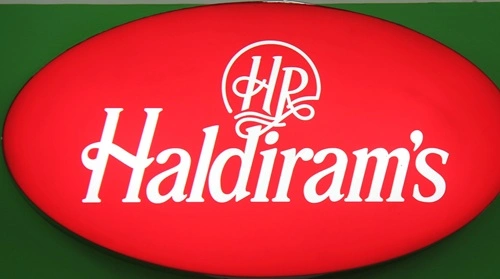In FY 2024, Haldiram’s delivered a combined revenue of ₹12,800 crore, with an EBITDA of ₹2,580 crore and PAT around ₹1,350–1,400 crore. Temasek recently acquired a ~10% stake at a valuation of ~US $10 billion, underpinning both strong financials and investor confidence in its growth potential.

Introduction
Established in 1937 in Bikaner and now headquartered in Noida, Haldiram’s is India’s leading ethnic snacks powerhouse. With over 410 products spanning traditional sweets, namkeens, ready-to-eat meals, and frozen foods, the company caters to a variety of consumer segments both domestically and internationally. Haldiram also operates 150+ quick-service restaurants (QSRs) and supplies to major retail and e‑commerce channels. In FY 2024, it held ~13% share of the organized Indian snacks market, exporting to over 80 countries, largely leveraging its strong brand and supply chain network.
Strengths
1. Dominant brand equity & heritage: A legacy brand with over eight decades of consumer trust, Haldiram’s commands unmatched mindshare in traditional snack categories, reinforcing loyalty across generations.
2. Extensive and diversified product portfolio: With more than 410 SKUs including namkeen, sweets, RTE foods, frozen meals, beverages and bakery lines, Haldiram’s mitigates product-risk and captures multiple occasions.
3. Robust distribution and operational scale: Manufacturing bases in Nagpur, Delhi, Bikaner and Kolkata support distribution across India and exports to 80+ countries. Efficient vertical integration and cost discipline enable strong margins (~25–40%) and operating returns (RoCE >20%).
4. Financial strength with investor backing: Strong cash accrual (~₹1,000 cr annually), negligible debt, and recent large investments from Temasek, Alpha Wave Global and IHC boost both liquidity and strategic options including a possible IPO.
5. QSR footprint & retail presence: Haldiram’s owns over 150 restaurant outlets in high-density markets and plans 150–200 more across central and southern India—augmenting its packaged-food business with experiential engagement and high margin QSR-style revenues.
Weaknesses
1. Fragmented organisational structure: Legacy splits among Delhi, Nagpur, and Kolkata branches have created operational inefficiencies and brand inconsistency. While the Delhi and Nagpur entities have merged, the Kolkata faction still operates independently, complicating unified strategy.
2. Limited presence in health-oriented segments: Though recent launches include healthier snack lines, Haldiram’s core remains heavy on fried, oil-rich products—less appealing to health-conscious millennials and newer-age consumers.
3. Underdeveloped modern retail and digital channels: Reliance on traditional trade channels and slower e‑commerce penetration limits exposure to rapidly growing online shoppers and modern trade formats.
4. Price positioning challenges: Premium pricing in some markets alienates price-sensitive customers, especially in smaller towns, ceding share to low-cost competitors like Bikaji and regional unorganized players.
Opportunities
1. Product innovation & health-focused range: Introducing low-fat, gluten-free, baked, millet-based and organic snacks can help Haldiram’s tap into the booming health snacking segment, projected to grow rapidly over the next decade.
2. Strategic digital & e‑commerce expansion: Leveraging e‑commerce giants (Amazon, BigBasket, Flipkart) and investing in D2C channels will extend reach beyond traditional retail and attract younger demographics.
3. QSR expansion: Plans to open 50 new QSR outlets in Tier‑2 and Tier‑3 cities over 12–18 months provide a strong platform to expand in experiential food and convenience food markets.
4. International growth beyond diaspora markets: Expanding into non‑Indian consumer segments via fusion flavors, global branding, and partnerships can reduce dependency on diaspora buyers and enhance global presence.
5. IPO and institutional capital deployment: With Temasek and other investors on board, a potential IPO can raise significant capital for capacity expansion, R&D, and marketing innovation.
Threats
1. Intensifying competition: Peer brands such as Bikaji, Bikanervala, local regional players, and multinationals like ITC, PepsiCo and Britannia are aggressively capturing market share, especially in modern trade and premium snack segments.
2. Shifting consumer preferences: As consumers pivot toward healthier snacking options, demand for traditional fried items may decline, requiring innovation and reformulation .
3. Raw-material and supply chain volatility: Dependence on palm oil, pulses, sugar, and gram flour exposes margins to commodity cycles and potential disruptions due to climate or geopolitical factors.
4. Regulatory scrutiny & food safety norms: Stringent FSSAI compliance, potential recalls, and differentiation across multiple subsidiaries add operational risk and cost burdens.
5. Organizational alignment post-merger: With the Kolkata faction still outside merged entity, branding overlaps and governance conflicts may persist, complicating cohesive strategy execution .
Future Outlook
Looking ahead into FY 2026 and beyond, Haldiram’s faces a pivotal phase of growth transformation. Key strategic imperatives include:
Complete brand consolidation of all regional entities to achieve streamlined governance and unified execution.
Accelerate healthy-snack innovations, tapping into rising urban health awareness with formats like baked, millet-based, and low-sugar products.
Expand QSR footprint into emerging India—opening 150–200 outlets across southern and central regions in the next two years.
Drive e‑commerce and digital engagement, using social media, D2C initiatives, and influencer marketing to target millennials.
Prepare IPO to capitalize on capital inflows for scaling manufacturing, enhancing R&D, and building a stronger marketing funnel.
Diversify global footprint beyond diaspora markets through tailored product offerings and collaborations with global retailers.
Protect margins by optimizing procurement, deploying cost hedging, and expanding private-label products.
If Haldiram’s can unify its structure, modernize its product mix, scale retail operations (including QSR and digital), and manage competition and regulatory complexity deftly, it is well positioned to grow revenue at 8–10% CAGR and sustain RoCE above 20%, solidifying its role not just as India’s snack king, but a global ethnic foods force.